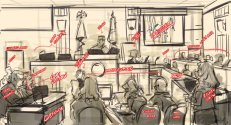Summary of tweets for Thursday, April 27th - Day 12
State witness:
Douglas Halepaska. A forensic examiner in the firearms & tool marks division in the FBI lab in Quantico, Virginia.
Nate Eaton
@NateNewsNow
·
2h
Next witness called to the stand is Douglas Halepaska. He works in the FBI lab in Quantico, Virginia. He's a forensic examiner in the firearms and tool marks division. Fremont County Deputy Prosecuting Tawyna Rawlings is questioning Halepaska.
Halepaska explains the training he received to be a tool mark examiner. He's worked with tools and firearms in different training facilities and has passed several oral and written exams.
Halepaska has worked at the Quantico lab for over 13 years. Evidence typically arrives via Fed Ex but sometimes it's hand delivered. Someone receives the evidence, enters it into a software system, takes inventory and puts together an examination plan.
When evidence arrives at the firearm/tool mark unit, an examiner or technician picks it up and puts it into a storage facility. Halepaska recalls receiving the evidence from the Ada County Coroner's Office.
Halepaska asks to review his notes. The defense has a right to see the notes before he looks them over so Thomas is reviewing them. Lori is chatting with Jim Archibald, her other attorney.
Halepaska explains the first thing he does in reviewing evidence is open up the package. He then reviews the evidence for any tool marks. He documents it in his notes with images or handwritten. "A tool can be thought of when two objects come in contact with each other.
The harder of the two objects is called the tool, the softer of the objects is called the tool mark."
Rawlings asks Halepaska if he used casting material. He says he did. "Casting material is a silicon-based compound. It's administered onto a surface as a thick liquid.
Once that substance dries, it dries into a rubberized material and picks up casting of the items." Halepaska took five castings of the evidence items.
Halepaska explains types of tool marks and impressions that can be found on objects.
Halepaska says during the first part of his examination process, he documents everything in his notes. During the next level of the exam, he brings in a comparison microscope that allows him to look at two separate samples using the same viewing field and magnification.
Rawlings asks to admit some photographs. Thomas looks over them and says he has a question for Rawlings. They walk into the corner of the courtroom. There is no white noise today. Boyce says there are some tech issues that should hopefully be resolved during lunch.
Thomas returns to his seat. Rawlings continues to question Halepaska about the photos. He says they are pictures taken during the exam period from Feb. 2021-Oct. 2021. Halaepaska placed markings on the photos and bones.
An image of the hip bone is displayed on the screen. Halepaska points out damage on the bone and says there are signs of stabbing and chopping-type actions.
The next photo is a close-up of the hip bone where Halepaska says there was evidence of a stabbing-action. "You can actually see some of the bone here has begun to fracture and the force of the impact came down at a perpendicular angle.
This fracturing that's occurring has been driven to the bone. The bone has a hard layer and a hallowed layer inside. This penetrated the hard layer into the hallow layer and there was damage that occurred on the other side of the bone."
Halepaska applied the casting material to the damaged part of the bone and let it harden. He did this twice and was unable to identify any characteristics of the tool that possibly caused the damage.
The next image shows more damage and fractures to the hip bone. Halepaska says the damage was caused by a chopping-type action. "It didn't drive all the way through the hard layer of the bone but you can see basically part of the bone of the damaged area."
Halepaska says he took a casting of this part of bone but was unable to identify characteristics of the injury.
The next slide shows multiple images. The top picture shows close-up images of the tool marks found on the bone. During the presentation, Lori is drawing or writing on her notepad, whispering to her attorneys and drinking from a cup of water.
Halepaska wasn't able to determine the exact tools that caused the marks but he speculates they came from a bladed tool such as a machete or hatchet.
Another photo shows a crack in the bone that cut through the hard layer and transferred to the other side of the bone. "It indicates to me there may have been some type of serrated edge on the blade," Halepaska says, adding that it came from a chopping-type action.
We now see a photo of the backside of the hip bone. It shows damage from a stabbing-type action that went through the bone to the outside. "I believe it was some type of bladed tool like a knife however I couldn't preclude other tools that might have some type of pointed edge."
Rawlings presents more photos showing damage to bones. We now see an intact portion of Tylee's spine. It has marks consistent with a chopping-type action, Halepaska says.
The next image is the other half of the hip or pelvic region. There is some damage created from a chopping-type action that pierced the hard layer of the bone.
There are soot marks on the bone that were damaged due to fire. "I was unable to find any tool marks but it does appear some type of force was applied to it perpendicular driving it downward but it was still attached to the bone."
We are now viewing another photo showing a bone damaged from a chopping-type action, Halepaska explains. He believes the marks came from a blade tool such as a cleaver, machete or hatchet.
We now see a photo with a big black crack in a bone. "This is from a chopping-type action. The force of the action occurred from left to right, kind of coming upward," Halepaska says.
The last image shows a large piece of Tylee's hip bone. Halepaska says some type of force was applied because there's an impression on it. There are other areas of damage.
We have another image displayed on the screen showing the totality of all the bones Halepaska examined. You see both hips and the spine/vertebrae. He marked all of the spots that were damaged and there are a lot of them.
The last picture is the backside of the bones we just saw. Halepaska points out lots of stabbing and chopping-type action marks on the image.
Rawlings asks Halepaska to summarize his findings. He says he was able to outline tools that could have produced the marks but could not specifically determine each individual item.
He says marks likely came from a knife, hatchet, cleaver, something with serrated teeth marks, a machete or other tools.
Rawlings has no further questions for Halepaska. Thomas will conduct cross-examination.
Thomas asks Halepaska about his background and where he received his education. Halepaska explains where he went to school and that he is currently enrolled in classes that require federal security clearances.
Boyce announces that we are taking the morning recess for 20 minutes.
We are back in court. Thomas asks Halepaska when he started the National Intelligence University, where he is currently enrolled. Thomas asks Halepaska for his employment history out of college.
Halepaska says after he graduated college, he was reactivated in the Marine Corp. following 9/11. Thomas thanks him for his service.
Halepaska says examinations similar to this case are "infrequent" and he has maybe done them 5-6 times over his career.
Halepaska says he tries to use tools to replicate marks on other types of materials. He used replicas of knives, hatchets, machetes and "a lot of different tools" to determine what was used in this case.
None of the tools seized from Chad Daybell's property were used in the testing, Halepaska says. He says no tools were submitted to the lab - he just tested the bones.
Halepaska says it would have been helpful to have tools to analyze in the case.
Halepaska says his analysis was focused solely on the marks and damage to the bones - not flesh or skin.
Thomas asks, "Is it true you don't know what caused these marks, you just know it was something?" He responds, "All I know is the marks were generated by some tool that is consistent in generating those marks but I don't know what was used."
Halepaska says a lot of disciplines exist in the FBI laboratory and they try to help as much as possible but they are limited based on the evidence given to them.
Thomas asks for clarification on the difference between the stabbing and chopping tool marks. "I'm a little confused which is which." Halepaska says in the stabbing, the energy is being transferred from the tool to the surface and is focused on a very narrow area.
The chopping action force is being applied over a long-access area. Thomas has no further questions.
Rawlings have some follow-up questions for clarification.
Halepaska's testimony is over. He is released from the stand.
link:
https://twitter.com/NateNewsNow



